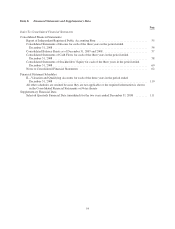Yahoo 2008 Annual Report Download - page 55
Download and view the complete annual report
Please find page 55 of the 2008 Yahoo annual report below. You can navigate through the pages in the report by either clicking on the pages listed below, or by using the keyword search tool below to find specific information within the annual report.include revenues from a variety of consumer and business fee-based services. While the majority of our revenue
transactions contain standard business terms and conditions, there are certain transactions that contain
non-standard business terms and conditions. In addition, we may enter into certain sales transactions that involve
multiple elements (arrangements with more than one deliverable). We also enter into arrangements to purchase
goods and/or services from certain customers. As a result, significant contract interpretation is sometimes
required to determine the appropriate accounting for these transactions including: (1) whether an arrangement
exists; (2) how the arrangement consideration should be allocated among potential multiple elements; (3) when
to recognize revenue on the deliverables; (4) whether all elements of the arrangement have been delivered;
(5) whether the arrangement should be reported gross as a principal versus net as an agent; (6) whether we
receive a separately identifiable benefit from the purchase arrangements with our customer for which we can
reasonably estimate fair value; and (7) whether the arrangement should be characterized as revenue or a
reimbursement of costs incurred. In addition, our revenue recognition policy requires an assessment as to
whether collection is reasonably assured, which inherently requires us to evaluate the creditworthiness of our
customers. Changes in judgments on these assumptions and estimates could materially impact the timing or
amount of revenue recognition.
Income Taxes. Significant judgment is required in evaluating our uncertain tax positions and determining our
provision for income taxes. Effective January 1, 2007, we adopted the provisions of FIN 48. See Note 10—
“Income Taxes” in the Notes to the consolidated financial statements for additional information. We establish
reserves for tax-related uncertainties based on estimates of whether, and the extent to which, additional taxes will
be due. These reserves are established when we believe that certain positions might be challenged despite our
belief that our tax return positions are in accordance with applicable tax laws. We adjust these reserves in light of
changing facts and circumstances, such as the closing of a tax audit, new tax legislation, or the change of an
estimate. To the extent that the final tax outcome of these matters is different than the amounts recorded, such
differences will affect the provision for income taxes in the period in which such determination is made. The
provision for income taxes includes the effect of reserve provisions and changes to reserves that are considered
appropriate, as well as the related net interest and penalties.
We record a valuation allowance against certain of our deferred income tax assets if it is more likely than not that
those assets will not be realized. In evaluating our ability to realize our deferred income tax assets we consider all
available positive and negative evidence, including our operating results, ongoing tax planning and forecasts of
future taxable income on a jurisdiction by jurisdiction basis. In the event we were to determine that we would be
able to realize these deferred income tax assets in the future, we would make an adjustment to the valuation
allowance, which would reduce the provision for income taxes. We increased our valuation allowance by $17
million during the year ended December 31, 2008. This increase is mainly attributable to international net
operating loss carryforwards.
Goodwill. Goodwill is not amortized, but is tested for impairment on an annual basis and between annual tests in
certain circumstances. The performance of the goodwill impairment test involves a two-step process. The first
step involves comparing the fair value of our reporting units to their carrying values, including goodwill. If the
carrying value of the reporting unit exceeds its fair value, the second step of the test is performed by comparing
the carrying value of the goodwill in the reporting unit to its implied fair value. An impairment charge is
recognized for the excess of the carrying value of goodwill over its implied fair value.
Our reporting units are based on geography, either at the operating segment level or one level below operating
segments. The fair values of our reporting units are estimated using an average of a market approach and an
income approach as this combination is deemed to be the most indicative of our fair value in an orderly
transaction between market participants and is consistent with the methodology used for the goodwill impairment
test in the prior year. In addition, we ensure that the fair values estimated under these two approaches are
consistent with each other. Under the market approach, we utilize publicly-traded comparable company
information to determine revenue and earnings multiples that are used to value our reporting units adjusted for an
estimated control premium. Under the income approach, we determine fair value based on estimated future cash
49
























